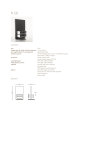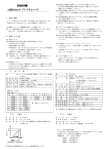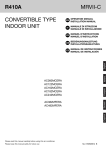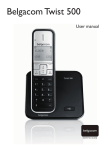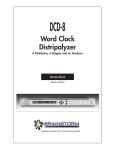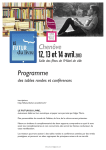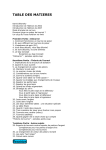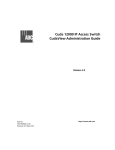Download Time Code Distributor - Brainstorm Electronics
Transcript
SR-28 Time Code Distributor Operation Manual BRAINSTORM ELECTRONICS, INC. www.brainstormtime.com Distributed Exclusively by plus24 1155 N. La Brea Avenue, West Hollywood, CA 90038 - USA Tel: (323) 845-1171 - Fax: (323) 845-1170 www.plus24.net ...Intelligent Solutions For The Recording Studio SR-28 User Manual Page 1 1. Introduction Congratulations on purchasing the SR-28 Time Code Distributor. The SR-28 is a high quality reshaper designed to recondition very low level or amplitude distorted time code into a properly shaped waveform and to distribute it through its 8 individually [n__^k^]hnminml'>Z\ahnminmaZlbmlhpge^o^eZ]clnmihm' There are 2 separate time code inputs that can be selected via a front panel switch or, alternatively via an external remote switch. Two separate power supplies can be connected into the SR-28 for redundancy. 2. Installation 2.1. UNPACKING When unpacking your SR-28 the following items should be in the shipping carton: LK&+1ngbm Ngbo^klZeIhp^kLniier!*+O=<%*',:" B><ihp^k\Z[e^ Hpg^klFZgnZeK^`blmkZmbhg\Zk] 2.2. INSTALLING THE SR-28 The SR-28 is designed to be mounted in a standard 19” rack. It is 1U in height. Usual precautions should be respected when wiring the SR-28: use high quality cables with good shield to guarantee a good signal transmission. Keep your cables as short as possible. To preserve the integrity of the transmission line, it is recommended that you do ghmfnemZlbg`e^hnminmmhfnembie^]^ob\^lZlbm\Zg]^`kZ]^lb`gZejnZebmr' Page 2 SR-28 User Manual ,'B(Hl=^l\kbimbhgZg]<Z[e^K^jnbk^f^gml SR-28 User Manual IZ`^, -'-'IHP>K To turn the unit on, tap the [POWER] button. There will be a small delay before the unit actually turns on. To turn the unit off, hold the [POWER] button for about 2 seconds. Pa^gma^LK&+1blmnkg^]hg%ma^Ihp^k:Zg](hkIhp^k;E>=leb`amnimh indicate that power is present at the corresponding connector. When the SR-28 blh__%ma^l^E>=llmZrh__%^o^gpbmaihp^kik^l^gmZmma^\hgg^\mhk' ,'*IHP>K Ma^LK&+1k^jnbk^l*+O=<%*:':\\^imZ[e^kZg`^bl*+O=<$(&*.' The external supply provided with the SR-28Z\\^iml*))mh+-)O:<bginmZm .)&/)AslhbmbllnbmZ[e^_hknl^Zgrpa^k^bgma^phke]' HimbhgZeer%Zl^\hg]ihp^klniier\Zg[^\hgg^\m^]mhIhp^kBginm;_hk k^]ng]Zg\r!l^^-'-[^ehp"'Mhhk]^kZl^\hg]ihp^klniier!i(g3IL&0" contact your dealer. REDUNDANCY: The SR-28 has 2 power inputs and allows for 2 separate power supplies to be connected simultaneously. If one of the supplies fails, the second one will keep the SR-28 running. The LED corresponding to the faulty supply will start blinking to alert you. You can then replace it without having to power down. Note: For better failure protection, the 2 power supplies should be on separate mains circuits. ➢Bgl^kmma^-ibgien`bgmhma^k^ZkiZg^ecZ\dZg]l^\nk^[rl\k^pbg`ma^kbg`' Plug the supply into the wall outlet using the standard IEC cable supplied. ,'+MBF><H=>BGINML :\\^imlZgrmbf^\h]^_hkfZmZmli^^]lkZg`bg`_khf*(,)qmh/)qieZrli^^]' Connectors: XLR female ➢ Use a standard audio cable, Pin #2 Hot. Balanced or unbalanced systems. ,',MBF><H=>HNMINML <hgg^\mhk3+.ibg=?^fZe^!L^^:ii^g]bq<_hkpbkbg`]bZ`kZf" ➢Nl^lmZg]Zk]MZl\Zf(:ob]!=b`b]^lb`g"ZgZeh`Zn]bhibghnm\hg_b`nkZmbhg and if needed, a readily available DB-25 male to 8 XLR male break-out cable from third party companies. 4. ?khgmIZg^eLpbm\a^lE>=L -'*'BGINMLB@G:EE>=L Ma^l^+E>=Lbg]b\Zm^maZmZlb`gZeblik^l^gmZmma^\hkk^lihg]bg`bginm' -'+'BGINML>E><MHKE>=L Tap the [SELECTOR] button to toggle between the 2 inputs'Hg^h_ma^+E>=leb`aml up to indicate which input is currently selected. If necessary, an external selector switch \Zg[^nl^]!l^^Zii^g]bq;" -','HNMINME>O>EL Ma^e^o^e_hk^Z\ah_ma^1hnminmlblZ]cnlmZ[e^obZ1_khgmiZg^eihml. Levels go _khf_neeh__mh$*+][' 5. Reshaping and distributing time code .'*'MBF><H=>=BLMKB;NMBHG Simply multing a time code source to multiple destinations can cause serious problems and is not recommended. The SR-28 eliminates these potential problems by providing 8 individually buffered and balanced outputs. .'+'K>LA:IBG@=BLMHKM>=MBF><H=> Hghe]^kZgZeh`mZi^fZ\abg^l!^li^\bZeerOMKl"%mbf^\h]^nlnZeeraZl improper rise/fall times, leading edge peaking and different amplitude levels hg hg^lZg] s^khl'Pbmafhk^fh]^kg^jnbif^gm%ma^lb`gZeblnlnZeer cleaner but can also get distorted by long cable runs and poor connections. As a result, time code can become unreadable. The SR-28 eliminates these amplitude distortions by reshaping the code to its original specifications. .','MBF><H=>E>O>E Level fluctuations or improper level can also render time code unreadable. Pbmama^LK&+1%^Z\ahnminmblbg]bob]nZeerZ]cnlmZ[e^lhmaZmhimbfnfe^o^el can be sent to each reader. These levels remain constant regardless of input fluctuations. .'-'L>E><MBG@MA>IKHI>KKBL>MBF> Kbl^mbf^ebfbmbg`pZlli^\b_b^]bgLFIM>Zg]>;Nmhfbgbfbs^\khllmZed_khf time code into audio. A longer rise time removes more high frequency compo- Page 4 SR-28 User Manual SR-28 User Manual Page 5 nents from its waveform. However some equipment may not be able to read time code if its rise time is too long. :II>G=BQ;3NLBG@:G>QM>KG:ELPBM<A?HKBGINML>E><MBHG The SR-28 has three preset rise times for its output waveform: 25 µsec !LFIM>"%*l^\!ljnZk^pZo^"Zg].)l^\!>;N". When necessary an external switch can be used to change the SR-28 input selection. Pbk^bmmhma^+iZ]leZ[^e^]>QM>KG:ELPBM<A<HGG><MBHGhgma^fhma^k board. A 2 pin header can be soldered in the mother board with a connector at the end of the wires for easy disconnect. This external switch should be momentary SPST and will operate in parallel with the front panel switch. Either one can be used. The front panel LED always indicates the currently selected input. As a general rule, if time code is patched directly into a reader, use the square pZo^ihlbmbhg4[nm%pa^g^o^kihllb[e^\khll&mZedikh[e^fl^qblm!b'^'bgZgZn]bh iZm\a[Zr'''"hkpa^gk^\hk]bg`ma^k^laZi^]lb`gZe%nl^ma^LFIM>hk>;N l^mmbg`!Zlg^^]^]"' The rise time is set by default to square wave. To change it to one of the other ik^l^ml%fho^ma^bgm^kgZecnfi^kZllahpg[^ehp3 Specifications <HG?B@NK:MBHG +q1!p(bginml^e^\mhk" INPUT Signal Longitudinal Time Code !_hkpZk]hkk^o^kl^%ieZr%lanmme^pbg]" 6. Appendix :II>G=BQ:&+.ibg=<HGG><MHKPBKBG@=B:@K:F SMPTE/EBU HNMINM Ma^]bZ`kZf[^ehplahplma^ibg&hnm_hkma^+.ibg=&Ln[\hgg^\mhk!hnminml*&1"3 Impedance +)DĞ[ZeZg\^]4*)DĞng[ZeZg\^] Level &,)][Nfbg4$+)][NfZq Impedance /))Ğ[ZeZg\^]4,))Ğng[ZeZg\^] Level _neeh__mh$*)][N[ZeZg\^]4mh$-][Nng[ZeZg\^] _khgmiZg^eihmlZ]cnlmZ[e^ Waveform +.l!SMPTE"%.)l!EBU"%hk*l!ljnZk^pZo^" l^e^\mZ[e^kbl^mbf^!hg[hZk]cnfi^kl" <HGG><MHKL E>=L IHP>K =BF>GLBHGL WEIGHT Amplitude Distortion e^llmaZg+ Inputs QEK?^fZe^!+"&Ibgl3,6ab`a4+6ehp4*6`khng] Hnminml =;+.?^fZe^!1\aZgg^el" Bginm:; Signal present Input select <nkk^gmerl^e^\m^]Bginm!:hk;" Power Ihp^kik^l^gm!:;" *+O=<%*',:!ngbo^klZelniierikhob]^]"




